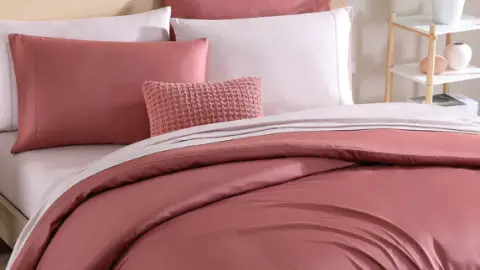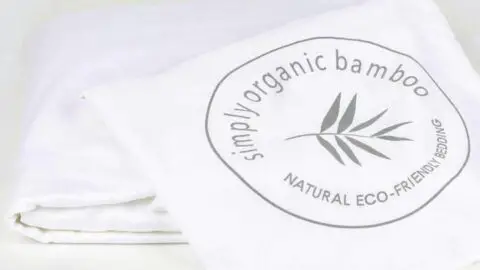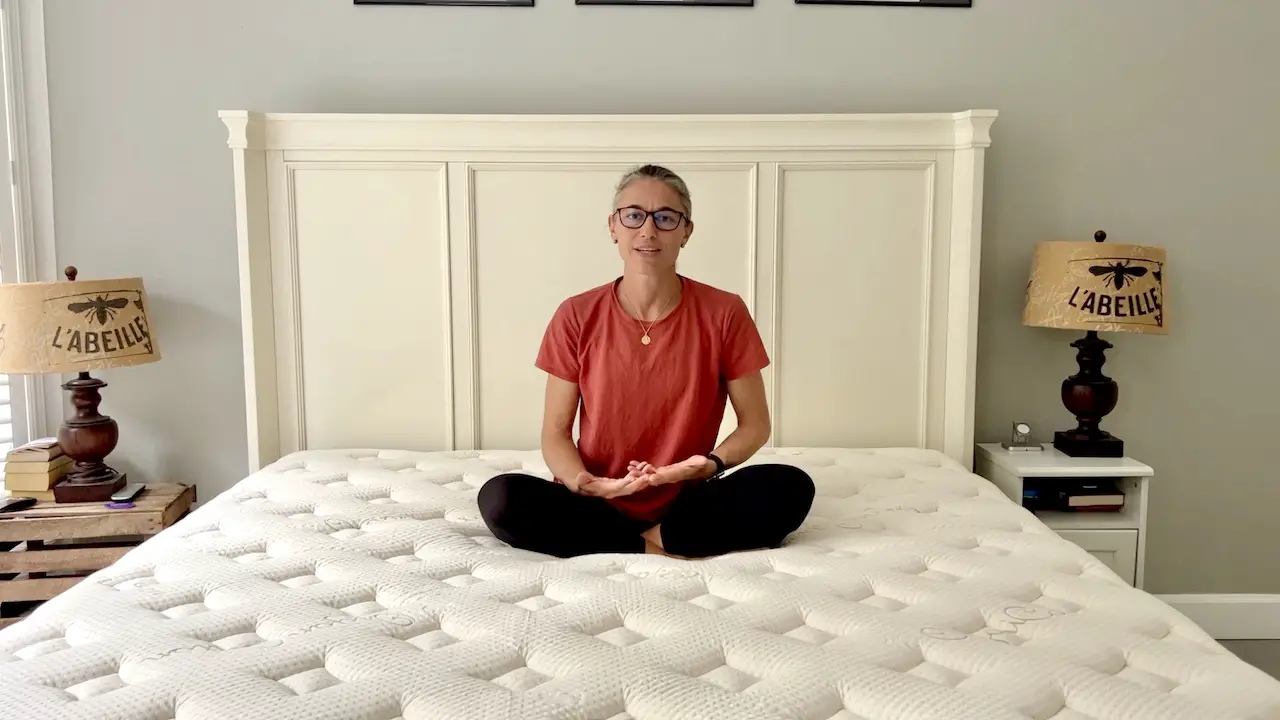WHAT IS VISCOSE FROM BAMBOO
Understanding the Popular Bamboo-Derived Fabric in Bedding and Sleep Products
If you’ve been shopping for sheets, mattress toppers, or sleepwear recently, you’ve likely come across the term “viscose from bamboo.”
This bamboo-derived fabric has become a favorite in the bedding industry for its silky feel, temperature regulation, and sustainability claims. But what exactly is viscose from bamboo? Is it truly eco-friendly? And is it the best choice for a good night’s sleep?
Let’s take a closer look into what viscose from bamboo is, how it’s made, why it’s used in bedding, and what to consider before buying it. Whether you’re upgrading your sleep setup or simply want to understand the materials you’re sleeping on, this article covers everything you need to know.
Table of Contents
What Is Viscose from Bamboo?
Viscose from bamboo is a semi-synthetic fiber made by chemically processing bamboo pulp into a soft, breathable textile. Despite the natural origin of bamboo, the final fabric is categorized as a regenerated cellulose fiber—similar to rayon.
When you see sheets, comforters, or sleepwear labeled “bamboo” or “bamboo-derived,” it most commonly refers to viscose from bamboo. The term “viscose” refers to the process used to convert the raw bamboo into fiber.
In simple terms, bamboo is not just cut, spun, and woven—it’s broken down with chemicals, then reformed into a textile material. This is what makes viscose from bamboo so soft and popular, especially in the bedding industry.
How Is Viscose from Bamboo Made?
The manufacturing process for viscose from bamboo involves several steps:
1. Harvesting Bamboo
Bamboo is a fast-growing grass that requires minimal water and no pesticides. Manufacturers usually harvest Moso bamboo, which grows in abundance and isn’t part of the giant panda’s diet.
2. Pulping
The bamboo stalks are broken down into a pulp. This step removes the hard plant structure and isolates the cellulose—the part that can be turned into fiber.
3. Chemical Processing
The cellulose pulp is treated with chemicals like sodium hydroxide and carbon disulfide to dissolve it into a viscous solution. This is the origin of the term “viscose.”
4. Spinning into Fibers
The viscous liquid is pushed through spinnerets to form strands, which are then solidified in a chemical bath. The result is a soft, smooth fiber that can be woven into fabric.
5. Finishing
The fibers are washed, dried, and spun into yarn. This yarn is then woven into textiles used for sheets, pillowcases, comforters, and other bedding products.
Is Viscose from Bamboo Eco-Friendly?
This is one of the most frequently asked questions about viscose from bamboo. The answer is both yes and no—it depends on which part of the process you’re focusing on.
Why It Can Be Eco-Friendly
Bamboo is renewable: It grows rapidly and doesn’t require replanting.
No pesticides or fertilizers: Bamboo can thrive without harmful chemicals.
Low water usage: Bamboo uses far less water than cotton to grow.
Why It May Not Be Eco-Friendly
Chemical processing: The viscose process uses chemicals that can be harmful to workers and the environment if not managed properly.
Water pollution: If the chemicals aren’t captured and reused, they can pollute local water supplies.
Energy-intensive: The transformation from bamboo to viscose requires significant energy.
Some companies use closed-loop processing, which captures and reuses chemicals. If you’re concerned about sustainability, look for certifications like OEKO-TEX or FSC-certified bamboo, or brands that disclose their eco-practices.
Benefits of Viscose from Bamboo in Bedding
Why is viscose from bamboo so popular in bedding products like sheets, duvet covers, and pajamas? Here are the top benefits:
1. Ultra-Soft Feel
Viscose from bamboo is often compared to silk or high-thread-count cotton. It has a smooth, luxurious texture that feels great against the skin.
2. Breathability
The fabric allows air to flow, making it a top choice for hot sleepers. It helps regulate body temperature and prevents overheating during the night.
3. Moisture-Wicking
Viscose from bamboo is naturally moisture-wicking, which means it pulls sweat away from the body—another plus for people who tend to sleep hot.
4. Hypoallergenic
Viscose from bamboo resists dust mites and other allergens. It is ideal for people with allergies or sensitive skin.
5. Antibacterial Properties
Bamboo has natural antibacterial properties. Some of these may carry over into viscose fabric, helping reduce odor build-up in bedding.
6. Drapability and Aesthetic
Viscose from bamboo sheets drape beautifully across the bed, giving your bedroom a sleek, modern look.
Drawbacks of Viscose from Bamboo
As with any material, viscose from bamboo isn’t perfect. Here are a few potential downsides to be aware of:
1. Prone to Wrinkling
Viscose from bamboo wrinkles more easily than cotton or polyester. You may need to iron or steam it if you prefer a crisp look, though promptly removing it from your dryer will typically be enough to ensure limited wrinkles.
2. Price Point
Viscose from bamboo bedding is typically more expensive than polyester or basic cotton sheets—but often cheaper than organic or high-thread-count cotton. If you are looking for buttery-soft sheets, however, they carry high value!
3. Environmental Impact
Unless specifically processed using environmentally friendly methods, such as closed-loop processing, the chemical-heavy production process can be a concern for eco-conscious buyers.
Bamboo Viscose vs. Other Bamboo Fabrics
When shopping for bamboo bedding, you might come across different terms:
1. Viscose from Bamboo
The most common form. Chemically processed but ultra-soft and breathable.
2. Bamboo Lyocell
Also called Tencel from bamboo. Made using a closed-loop system, making it more eco-friendly than viscose. It is just as soft but usually pricier.
3. Bamboo Linen
Mechanically processed without chemicals. It is eco-friendly but much rougher in texture—similar to traditional linen. Less common in bedding.
Is Viscose from Bamboo Safe for Sensitive Skin?
Yes, viscose from bamboo is often recommended for people with eczema, psoriasis, or other skin sensitivities. The fabric’s soft, non-irritating texture and breathability can help prevent overheating and sweating—both of which can aggravate skin conditions.
However, because it is chemically processed, some individuals with extreme chemical sensitivities may prefer bamboo lyocell instead.
How to Care for Bamboo Viscose Bedding
To maintain the softness and longevity of your viscose from bamboo sheets or comforters, follow these care tips:
Machine wash in cold water
Use gentle detergent (avoid bleach and fabric softeners)
Wash on a gentle cycle
Tumble dry low or hang to dry
Avoid hot water and high heat, which can weaken the fibers
Don’t wring or twist—this can cause stretching and distortion
Some manufacturers offer pre-shrunk bamboo viscose bedding, but it is still wise to wash items gently to avoid damage.
Should You Choose Viscose from Bamboo Sheets?
Let’s help you decide if viscose from bamboo bedding is right for you:
Ideal For:
Hot sleepers needing breathable, moisture-wicking bedding
People with sensitive skin or allergies
Shoppers who value a silky-smooth, luxurious feel
Eco-conscious consumers (when buying from transparent, certified brands – see our recommendations below)
Not Ideal For:
Those wanting crisp, wrinkle-resistant sheets
Budget-conscious shoppers
People concerned about chemical processing in fabrics
If softness, comfort, and breathability top your list of bedding priorities, viscose from bamboo is an excellent option—especially if you choose from eco-conscious brands.
Non-Biased Reviews' Favorite Bamboo Sheets - Editor's Pick
Bamboo sheets are our favorite by far. Here are our absolute favorites, and bamboo sheets we think you would love too:
Aeptom
Aeptom manufactures our favorite bamboo bedding. Their sheets and covers are buttery soft, made of Tencel lyocell, and adding their Tencel Lyocell Comforter adds incredible softness and coziness to your bed! We recommend at least getting the comforter and the Aeptom Duvet Cover Set.
Sunday Citizen
We are forever fans of Sunday Citizen. There isn’t one bedding item we tried, that we did not fall in love with! The Bamboo Sheets are ultra soft (made from viscose from bamboo) and we love the color options, which are fun to mix and match. Sunday Citizen also offers a few comforters made of bamboo, which are incredibly soft, high-quality built, and look great on their own or mixed with the bamboo sheets!
Simply Organic Bamboo
Simply Organic Bamboo is a no-frill, high-quality, manufacturer of bamboo bedding. All of their products feel incredible and are some of our favorite bamboo options for the bedroom. The Bamboo Sheet Set (made from viscose from organically-grown bamboo) and Duvet Cover are a great addition to your bedroom – we recommend using them both for ultimate softness, and a nice combination with the Bamboo Comforter.
What Is Viscose From Bamboo - Final Thoughts
Viscose from bamboo has transformed the bedding industry by offering an ultra-soft, breathable, and luxurious material made from one of the world’s most sustainable plants.
While it is not without its environmental controversies, many brands are working to improve transparency and sustainability in their production methods.
If you are searching for bedding that helps you sleep cool, feels silky against the skin, and supports sensitive skin needs, viscose from bamboo may be just what your bed needs.
When shopping, always read the label carefully, look for reputable certifications, and follow care instructions to keep your viscose from bamboo bedding in top shape.
References
- Lewis Bamboo. Moso Bamboo. Retrieved from https://lewisbamboo.com/products/moso
- B The Change. (2024). How Viscose Rayon Fabric Masquerades as Bamboo Clothing. Retrieved from https://bthechange.com/how-viscose-rayon-fabric-masquerades-as-bamboo-clothing-b-the-change-media-89f0e3038179?gi=c96f6d1ff016
FAQ
Most frequent questions and answers
Viscose from bamboo is a soft, breathable fabric made by chemically processing bamboo pulp into fibers used in bedding and clothing.
It can be, but not always. While bamboo is sustainable, the viscose process uses chemicals—look for brands with eco-certifications or closed-loop systems.
Yes, it’s naturally breathable and moisture-wicking, making it ideal for regulating body temperature at night.
Yes, its soft, hypoallergenic texture is gentle on sensitive skin and helps reduce irritation.
Use cold water on a gentle cycle with mild detergent, and dry on low or hang dry to prevent damage.
What is viscose from bamboo?
Viscose from bamboo is a soft, breathable fabric made by chemically processing bamboo pulp into fibers used in bedding and clothing.
Is viscose from bamboo eco-friendly?
It can be, but not always. While bamboo is sustainable, the viscose process uses chemicals—look for brands with eco-certifications or closed-loop systems.
Is bamboo viscose good for hot sleepers?
Yes, it’s naturally breathable and moisture-wicking, making it ideal for regulating body temperature at night.
Can people with sensitive skin use bamboo viscose?
Yes, its soft, hypoallergenic texture is gentle on sensitive skin and helps reduce irritation.
How should I wash viscose from bamboo sheets?
Use cold water on a gentle cycle with mild detergent, and dry on low or hang dry to prevent damage.
Share this deal with a friend!

Laura Georgieff
Laura is a mother of three who did not sleep through the night for the first 5.5 years of her kids' lives. She is passionate about sleep quality and loves sharing her experience and knowledge of all thing bedding! It is her mission to help you make the best decisions when it comes to sleep and help you get the best deal on the market!









